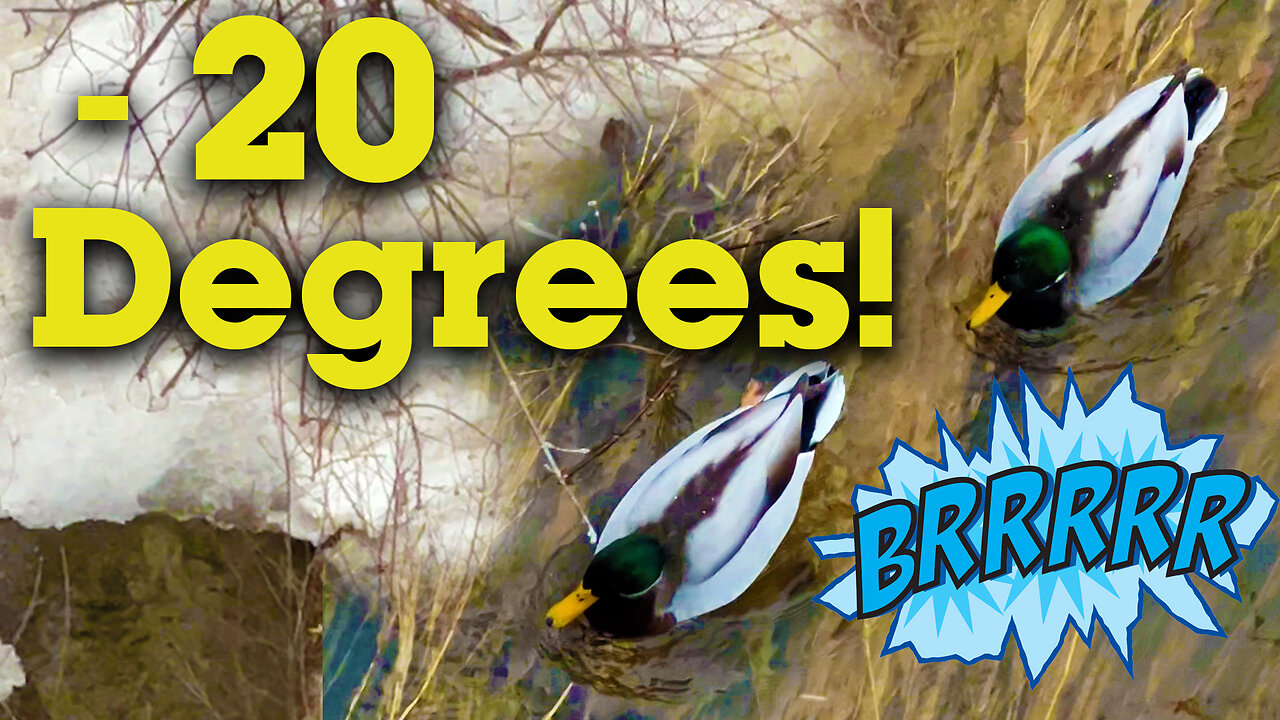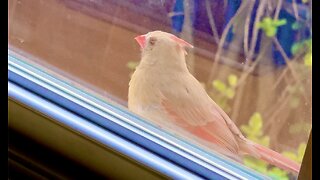Premium Only Content

FREEZING ducks? No way!
Minus 20 Degrees! Is that NICE weather for ducks?
I’m looking down from Ottawa’s Bank Street bridge through -20C (-4F) wind, snow and ice at the seemingly perfectly comfortable ducks below. Isn’t nature amazing?
How do ducks keep their feet from freezing in cold water?
We can understand how feathers protect water birds from almost freezing water, but how do they keep their feet from freezing?
Ducks adapt to cold weather by using a counter-current heat exchange system between the arteries and veins in their legs.
In ducks, veins that take blood from the extremities back to the heart, surround the arteries that take blood from the heart and pump it away to the extremities.
As the warm blood comes from the heart, it goes through the body and to the extremities, particularly the legs, and encounters veins. The warmth from the blood passes through to the surrounding vein and brings warm blood back to the body cavity.
As the blood enters the legs, it cools quite significantly. The feathered part of bird can be 25 C while the legs dip to 1 C. The bird therefore doesn't lose much heat to the environment.
The birds' legs also have tendons and bones instead of muscles and nerves like in mammals, which need more oxygenated blood.
Ducks can freeze to death in severe cold. Ducks are equipped with natural insulation in their bodies that helps them resist cold but prolonged exposure to extreme temperatures can lead to death.
Adult ducks are less susceptible to the cold than ducklings and, as a whole ducks are more resistant to cold than many other birds.
Here are three ways ducks protect themselves from low temperatures:
Possession of Preen Glands
A preen gland produces sebum (oil) and is located near the tail of ducks. When preening (i.e. rubbing their beak over their body to clean themselves and reposition their feathers), ducks spread the oil produced by the preen gland over their body.
Preening makes the feathers of ducks to become waterproof. Waterproof feathers permit very little or no amount of water (which easily gets cold) to reach the body of ducks.
So Many Downs
The down of birds is a type of feather that is soft with filaments scattered in every direction. Down feathers are below the feathers above. Down feathers are insulators as they trap air, and ducks can be warm even in harsh conditions).
Exchange of Blood Temperature in Their Legs
Ducks have feathers to protect their bodies from low temperatures. The only parts of the body of ducks without feathers are their legs.
Luckily, ducks (and a few other birds) are equipped with a marvelous exchange system in their legs. Their arteries and veins are so close, so when warm blood from their warm body flows into their legs, it increasing the temperature of the cold blood flowing into their body (from their legs). The ability to exchange blood temperature in their legs makes ducks walk on cold (or icy) surfaces for a long time without major impacts.
-
 0:04
0:04
AmplifiedLIFE
1 year ago $0.03 earned“Peep”-ing & Chirping Cardinal
115 -
 LIVE
LIVE
The Tom Renz Show
34 minutes agoThe Tariffs Are Coming!
186 watching -
 LIVE
LIVE
Film Threat
15 hours agoMINE CRAP?!!! + LOADS OF REVIEWS!!! | Film Threat Livecast
93 watching -
 LIVE
LIVE
The Shannon Joy Show
3 hours ago🔥🔥LIVE Exclusive With Dr. Mary Talley Bowden On Tucker Carlson Interview - ‘COVID Was The Most Evil Thing To Ever Have Happened To This Nation’ 🔥🔥
202 watching -
 1:01:10
1:01:10
VINCE
3 hours agoFirst Signs That Trump's Tariffs Are Paying Off | Episode 15 - 04/04/25
171K160 -
 1:09:14
1:09:14
BonginoReport
6 hours agoMoral Relativism, Tesla Terrorists & the Left: Jack Posobiec and Evita Unveil the Truth (Ep.175)
126K59 -
 LIVE
LIVE
Major League Fishing
2 days agoLIVE! - MLF Bass Pro Tour: REDCREST - Day 2
333 watching -
![🔴[LIVE] Stock Market Crash: From BAD To WORSE! || The MK Show](https://1a-1791.com/video/fww1/48/s8/1/f/N/-/y/fN-yy.0kob-small-The-MK-Show-Apr.-4th.jpg)
Matt Kohrs
13 hours ago🔴[LIVE] Stock Market Crash: From BAD To WORSE! || The MK Show
44.9K7 -
 1:08:06
1:08:06
The Big Mig™
5 hours agoPardon US: Justice For All w/ J6’r Daniel Goodwyn
10.1K3 -
 58:59
58:59
The Hannah Faulkner Show
14 hours agoHannah Faulkner and Dr. Simone Gold | NEW FDA DIRECTOR?!
15.4K1